Recording Business Transaction: Journal Entry, Ledger Account, Trial Balance, Income Statement, Balance Sheet
VerifiedAdded on 2022/12/15
|17
|2418
|56
AI Summary
This document provides a detailed explanation of recording business transactions through journal entry, ledger account, trial balance, income statement, and balance sheet. It emphasizes the importance of accurate financial statements and ratio analysis in analyzing business performance.
Contribute Materials
Your contribution can guide someone’s learning journey. Share your
documents today.
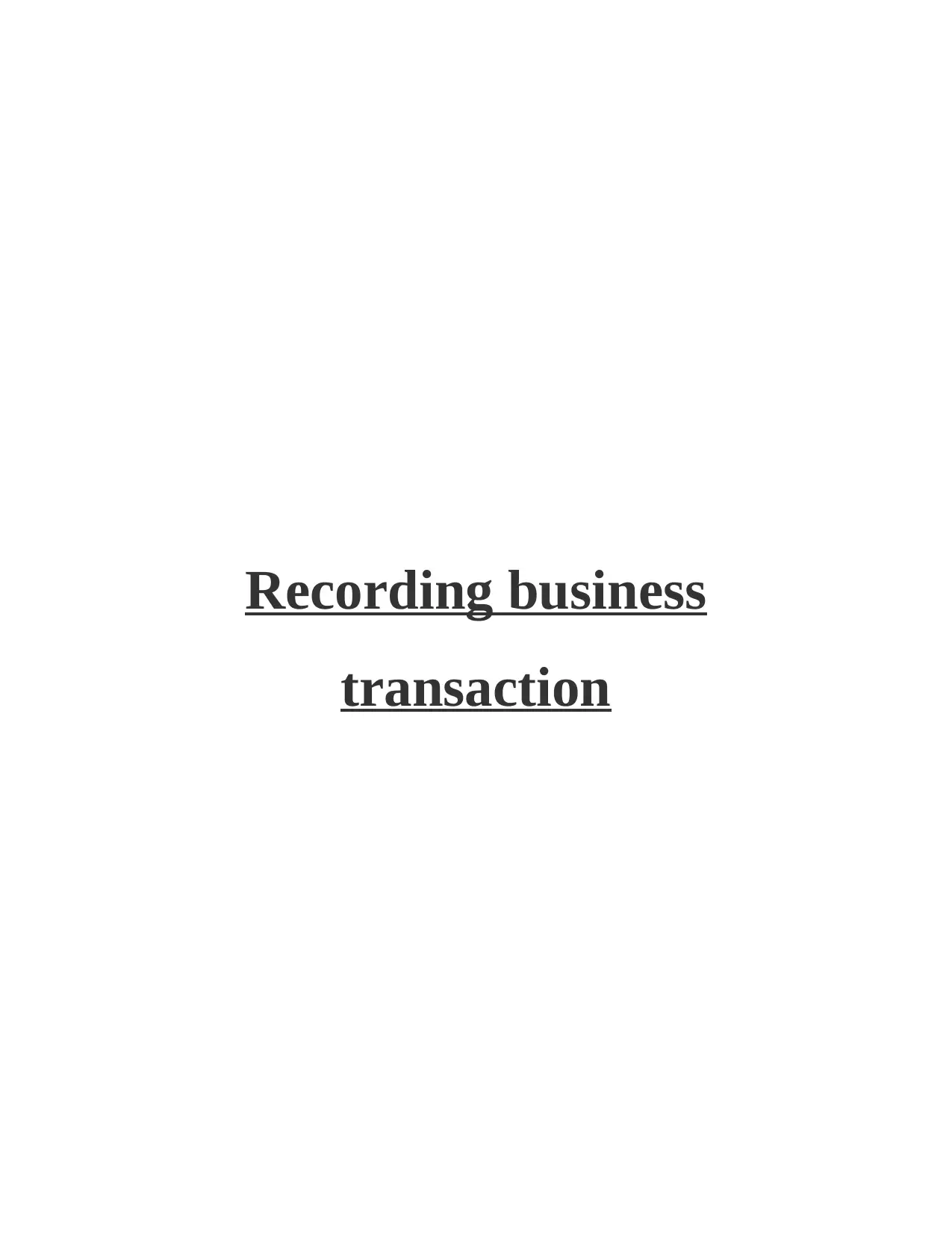
Recording business
transaction
transaction
Secure Best Marks with AI Grader
Need help grading? Try our AI Grader for instant feedback on your assignments.

TABLE OF CONTENTS
INTRODUCTION...........................................................................................................................3
MAIN BODY...................................................................................................................................3
Part A...............................................................................................................................................3
(a) Journal Entry..........................................................................................................................3
(b) Ledger Account......................................................................................................................4
(c) Trial Balance as at 31st October 2020....................................................................................9
(d) Income Statement.................................................................................................................10
(e) Balance Sheet as at 31st October 2020.................................................................................11
(f)................................................................................................................................................11
Part B.............................................................................................................................................12
(i) Ratio Analysis.......................................................................................................................12
(ii) Evaluation of the Linda's business performance on the basis of ratio analysis...................13
CONCLUSION..............................................................................................................................14
REFERENCE.................................................................................................................................15
INTRODUCTION...........................................................................................................................3
MAIN BODY...................................................................................................................................3
Part A...............................................................................................................................................3
(a) Journal Entry..........................................................................................................................3
(b) Ledger Account......................................................................................................................4
(c) Trial Balance as at 31st October 2020....................................................................................9
(d) Income Statement.................................................................................................................10
(e) Balance Sheet as at 31st October 2020.................................................................................11
(f)................................................................................................................................................11
Part B.............................................................................................................................................12
(i) Ratio Analysis.......................................................................................................................12
(ii) Evaluation of the Linda's business performance on the basis of ratio analysis...................13
CONCLUSION..............................................................................................................................14
REFERENCE.................................................................................................................................15
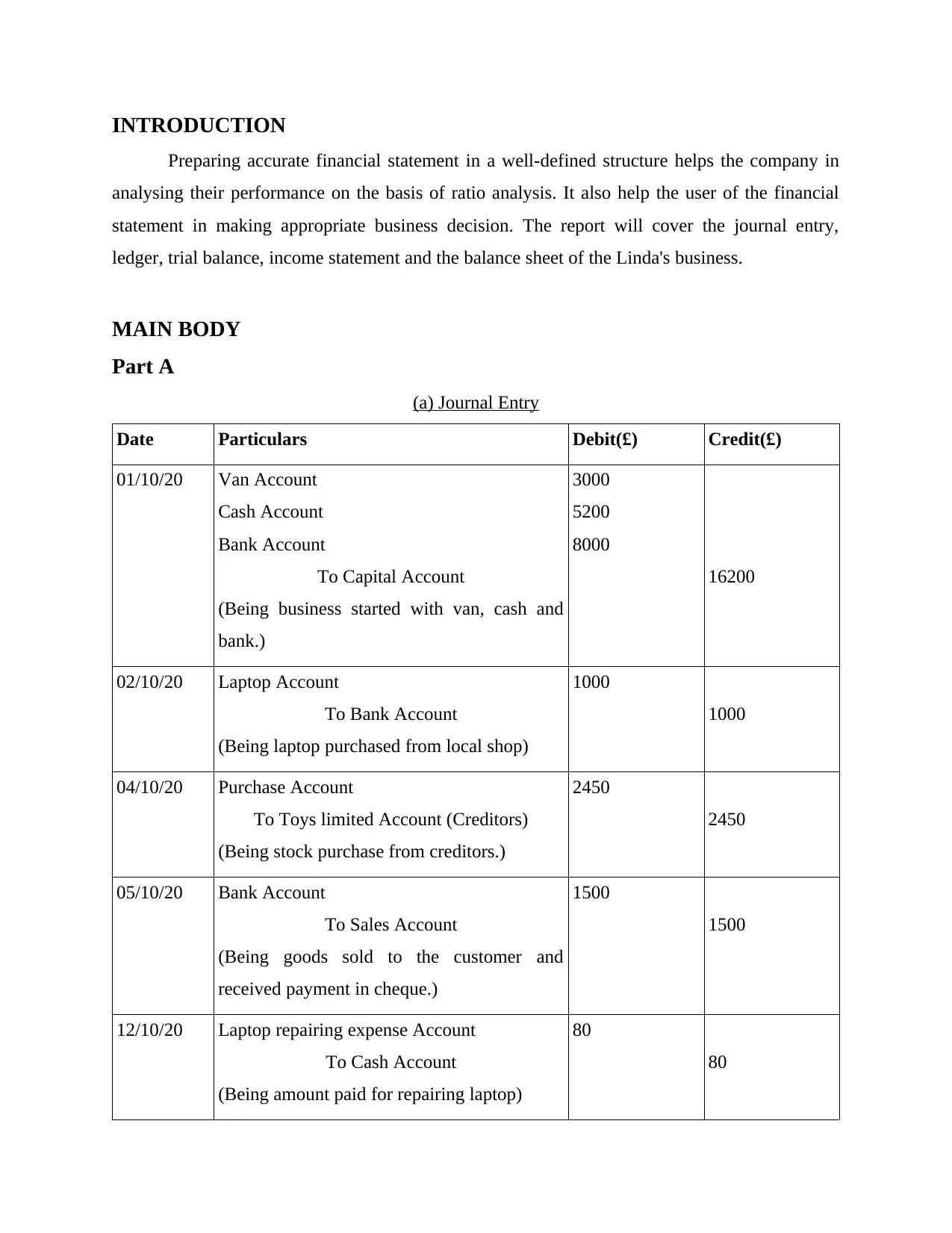
INTRODUCTION
Preparing accurate financial statement in a well-defined structure helps the company in
analysing their performance on the basis of ratio analysis. It also help the user of the financial
statement in making appropriate business decision. The report will cover the journal entry,
ledger, trial balance, income statement and the balance sheet of the Linda's business.
MAIN BODY
Part A
(a) Journal Entry
Date Particulars Debit(£) Credit(£)
01/10/20 Van Account
Cash Account
Bank Account
To Capital Account
(Being business started with van, cash and
bank.)
3000
5200
8000
16200
02/10/20 Laptop Account
To Bank Account
(Being laptop purchased from local shop)
1000
1000
04/10/20 Purchase Account
To Toys limited Account (Creditors)
(Being stock purchase from creditors.)
2450
2450
05/10/20 Bank Account
To Sales Account
(Being goods sold to the customer and
received payment in cheque.)
1500
1500
12/10/20 Laptop repairing expense Account
To Cash Account
(Being amount paid for repairing laptop)
80
80
Preparing accurate financial statement in a well-defined structure helps the company in
analysing their performance on the basis of ratio analysis. It also help the user of the financial
statement in making appropriate business decision. The report will cover the journal entry,
ledger, trial balance, income statement and the balance sheet of the Linda's business.
MAIN BODY
Part A
(a) Journal Entry
Date Particulars Debit(£) Credit(£)
01/10/20 Van Account
Cash Account
Bank Account
To Capital Account
(Being business started with van, cash and
bank.)
3000
5200
8000
16200
02/10/20 Laptop Account
To Bank Account
(Being laptop purchased from local shop)
1000
1000
04/10/20 Purchase Account
To Toys limited Account (Creditors)
(Being stock purchase from creditors.)
2450
2450
05/10/20 Bank Account
To Sales Account
(Being goods sold to the customer and
received payment in cheque.)
1500
1500
12/10/20 Laptop repairing expense Account
To Cash Account
(Being amount paid for repairing laptop)
80
80
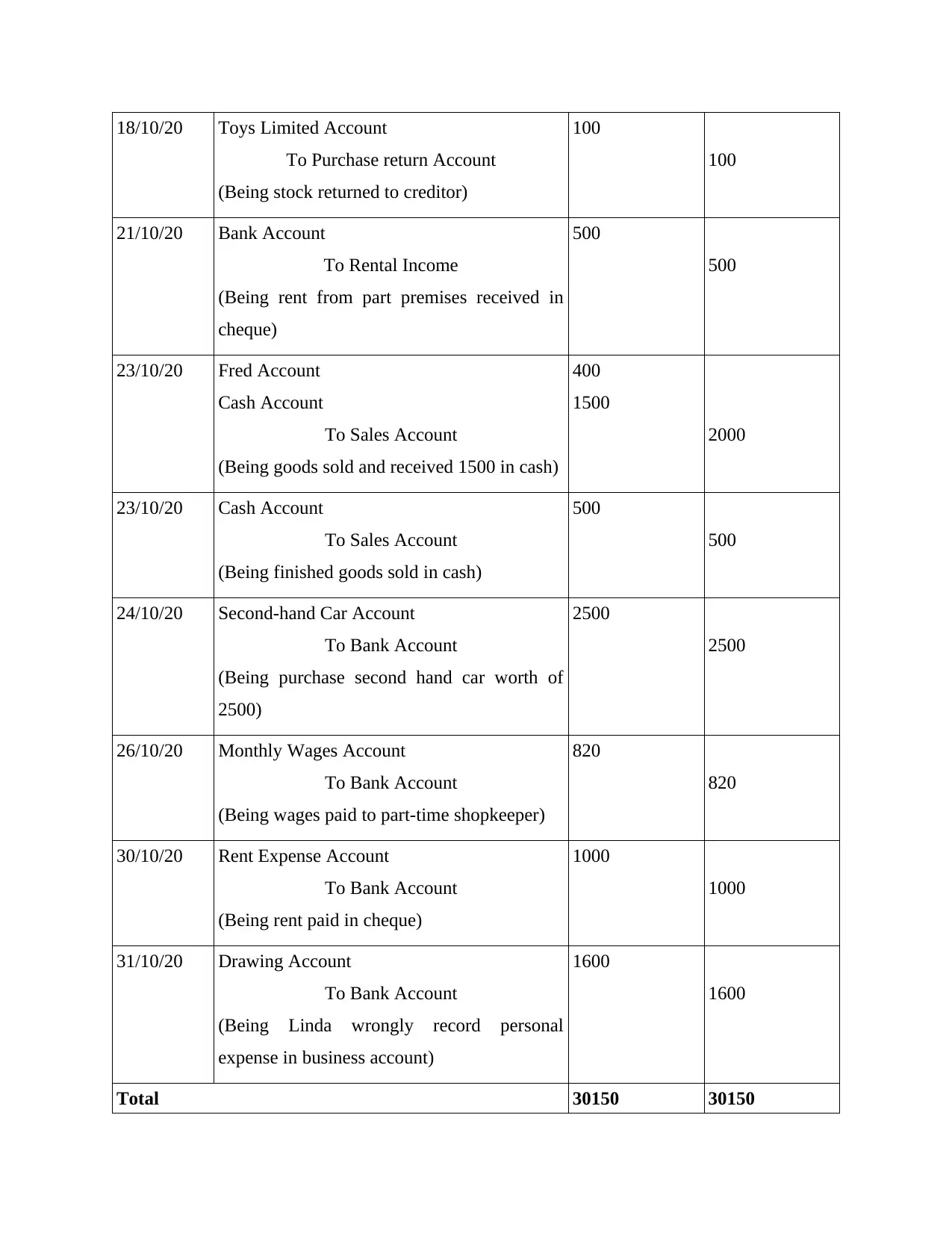
18/10/20 Toys Limited Account
To Purchase return Account
(Being stock returned to creditor)
100
100
21/10/20 Bank Account
To Rental Income
(Being rent from part premises received in
cheque)
500
500
23/10/20 Fred Account
Cash Account
To Sales Account
(Being goods sold and received 1500 in cash)
400
1500
2000
23/10/20 Cash Account
To Sales Account
(Being finished goods sold in cash)
500
500
24/10/20 Second-hand Car Account
To Bank Account
(Being purchase second hand car worth of
2500)
2500
2500
26/10/20 Monthly Wages Account
To Bank Account
(Being wages paid to part-time shopkeeper)
820
820
30/10/20 Rent Expense Account
To Bank Account
(Being rent paid in cheque)
1000
1000
31/10/20 Drawing Account
To Bank Account
(Being Linda wrongly record personal
expense in business account)
1600
1600
Total 30150 30150
To Purchase return Account
(Being stock returned to creditor)
100
100
21/10/20 Bank Account
To Rental Income
(Being rent from part premises received in
cheque)
500
500
23/10/20 Fred Account
Cash Account
To Sales Account
(Being goods sold and received 1500 in cash)
400
1500
2000
23/10/20 Cash Account
To Sales Account
(Being finished goods sold in cash)
500
500
24/10/20 Second-hand Car Account
To Bank Account
(Being purchase second hand car worth of
2500)
2500
2500
26/10/20 Monthly Wages Account
To Bank Account
(Being wages paid to part-time shopkeeper)
820
820
30/10/20 Rent Expense Account
To Bank Account
(Being rent paid in cheque)
1000
1000
31/10/20 Drawing Account
To Bank Account
(Being Linda wrongly record personal
expense in business account)
1600
1600
Total 30150 30150
Secure Best Marks with AI Grader
Need help grading? Try our AI Grader for instant feedback on your assignments.
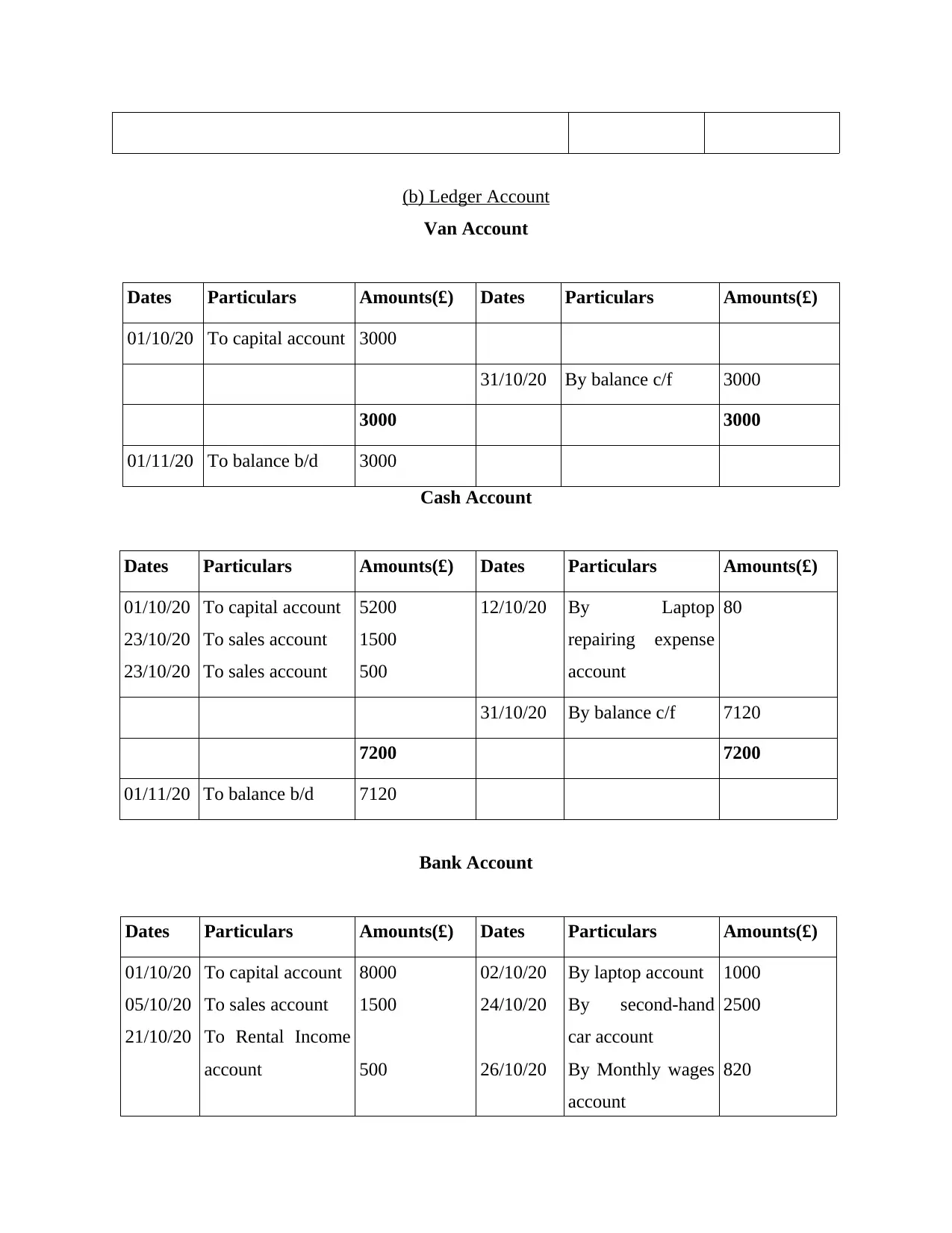
(b) Ledger Account
Van Account
Dates Particulars Amounts(£) Dates Particulars Amounts(£)
01/10/20 To capital account 3000
31/10/20 By balance c/f 3000
3000 3000
01/11/20 To balance b/d 3000
Cash Account
Dates Particulars Amounts(£) Dates Particulars Amounts(£)
01/10/20
23/10/20
23/10/20
To capital account
To sales account
To sales account
5200
1500
500
12/10/20 By Laptop
repairing expense
account
80
31/10/20 By balance c/f 7120
7200 7200
01/11/20 To balance b/d 7120
Bank Account
Dates Particulars Amounts(£) Dates Particulars Amounts(£)
01/10/20
05/10/20
21/10/20
To capital account
To sales account
To Rental Income
account
8000
1500
500
02/10/20
24/10/20
26/10/20
By laptop account
By second-hand
car account
By Monthly wages
account
1000
2500
820
Van Account
Dates Particulars Amounts(£) Dates Particulars Amounts(£)
01/10/20 To capital account 3000
31/10/20 By balance c/f 3000
3000 3000
01/11/20 To balance b/d 3000
Cash Account
Dates Particulars Amounts(£) Dates Particulars Amounts(£)
01/10/20
23/10/20
23/10/20
To capital account
To sales account
To sales account
5200
1500
500
12/10/20 By Laptop
repairing expense
account
80
31/10/20 By balance c/f 7120
7200 7200
01/11/20 To balance b/d 7120
Bank Account
Dates Particulars Amounts(£) Dates Particulars Amounts(£)
01/10/20
05/10/20
21/10/20
To capital account
To sales account
To Rental Income
account
8000
1500
500
02/10/20
24/10/20
26/10/20
By laptop account
By second-hand
car account
By Monthly wages
account
1000
2500
820
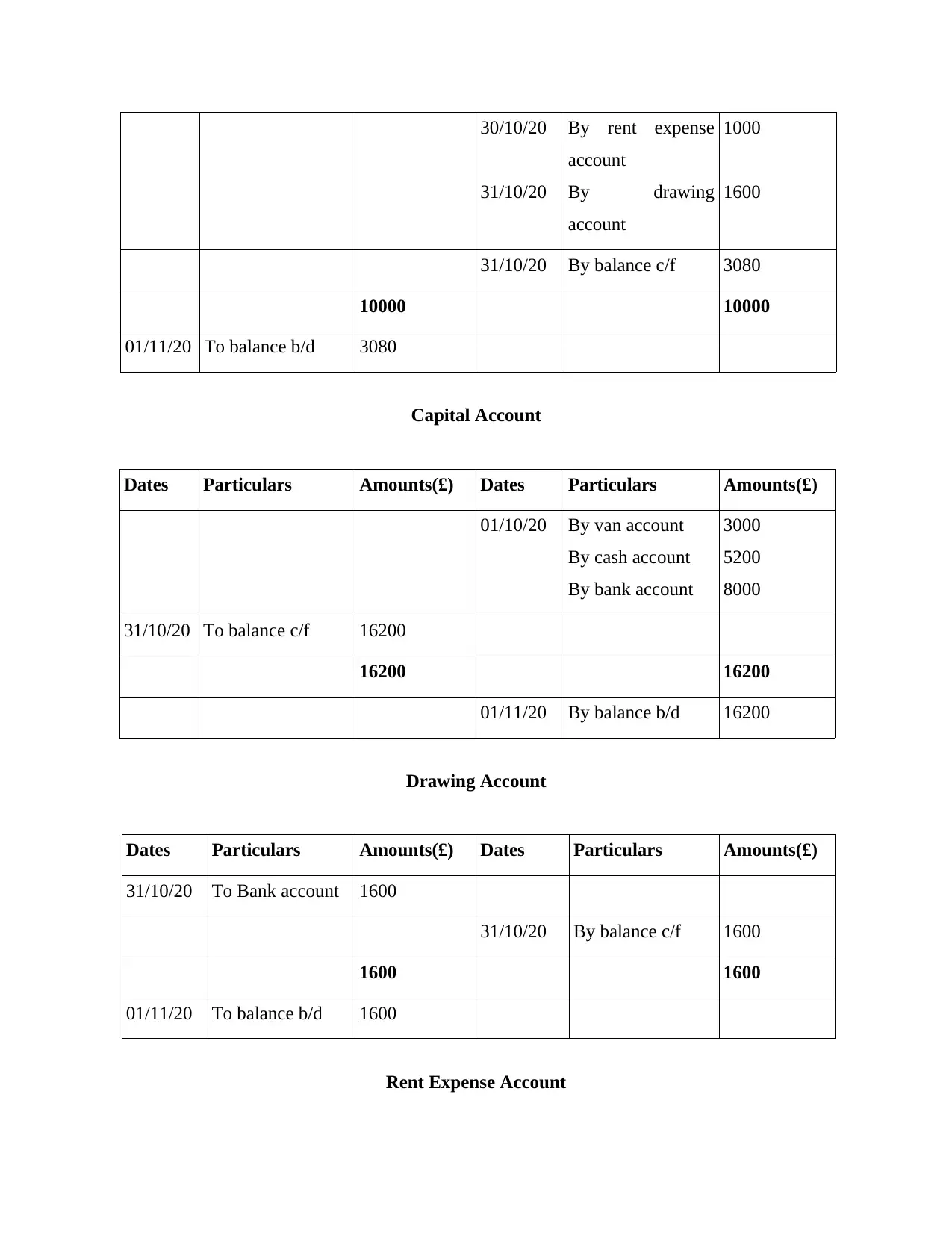
30/10/20
31/10/20
By rent expense
account
By drawing
account
1000
1600
31/10/20 By balance c/f 3080
10000 10000
01/11/20 To balance b/d 3080
Capital Account
Dates Particulars Amounts(£) Dates Particulars Amounts(£)
01/10/20 By van account
By cash account
By bank account
3000
5200
8000
31/10/20 To balance c/f 16200
16200 16200
01/11/20 By balance b/d 16200
Drawing Account
Dates Particulars Amounts(£) Dates Particulars Amounts(£)
31/10/20 To Bank account 1600
31/10/20 By balance c/f 1600
1600 1600
01/11/20 To balance b/d 1600
Rent Expense Account
31/10/20
By rent expense
account
By drawing
account
1000
1600
31/10/20 By balance c/f 3080
10000 10000
01/11/20 To balance b/d 3080
Capital Account
Dates Particulars Amounts(£) Dates Particulars Amounts(£)
01/10/20 By van account
By cash account
By bank account
3000
5200
8000
31/10/20 To balance c/f 16200
16200 16200
01/11/20 By balance b/d 16200
Drawing Account
Dates Particulars Amounts(£) Dates Particulars Amounts(£)
31/10/20 To Bank account 1600
31/10/20 By balance c/f 1600
1600 1600
01/11/20 To balance b/d 1600
Rent Expense Account
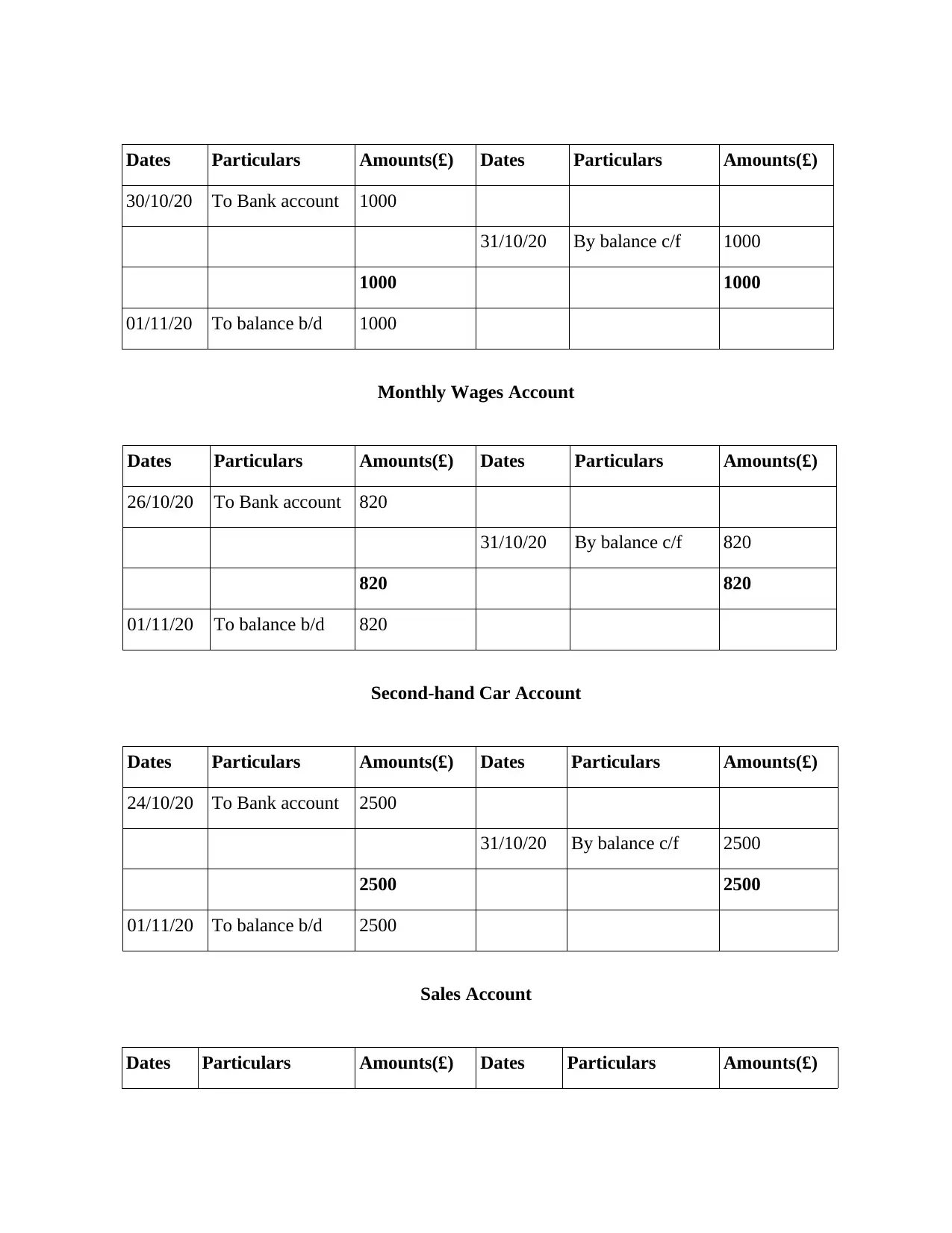
Dates Particulars Amounts(£) Dates Particulars Amounts(£)
30/10/20 To Bank account 1000
31/10/20 By balance c/f 1000
1000 1000
01/11/20 To balance b/d 1000
Monthly Wages Account
Dates Particulars Amounts(£) Dates Particulars Amounts(£)
26/10/20 To Bank account 820
31/10/20 By balance c/f 820
820 820
01/11/20 To balance b/d 820
Second-hand Car Account
Dates Particulars Amounts(£) Dates Particulars Amounts(£)
24/10/20 To Bank account 2500
31/10/20 By balance c/f 2500
2500 2500
01/11/20 To balance b/d 2500
Sales Account
Dates Particulars Amounts(£) Dates Particulars Amounts(£)
30/10/20 To Bank account 1000
31/10/20 By balance c/f 1000
1000 1000
01/11/20 To balance b/d 1000
Monthly Wages Account
Dates Particulars Amounts(£) Dates Particulars Amounts(£)
26/10/20 To Bank account 820
31/10/20 By balance c/f 820
820 820
01/11/20 To balance b/d 820
Second-hand Car Account
Dates Particulars Amounts(£) Dates Particulars Amounts(£)
24/10/20 To Bank account 2500
31/10/20 By balance c/f 2500
2500 2500
01/11/20 To balance b/d 2500
Sales Account
Dates Particulars Amounts(£) Dates Particulars Amounts(£)
Paraphrase This Document
Need a fresh take? Get an instant paraphrase of this document with our AI Paraphraser
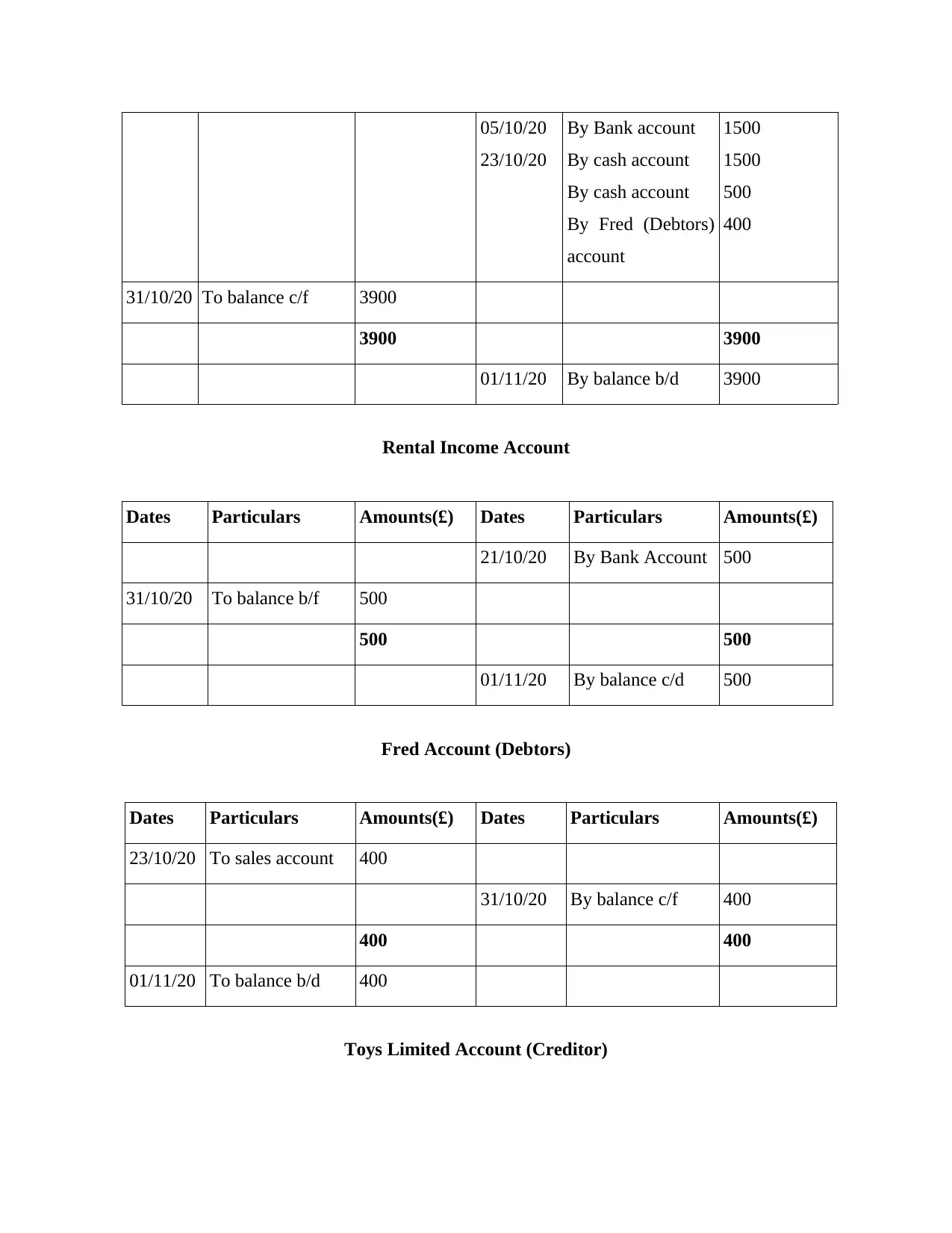
05/10/20
23/10/20
By Bank account
By cash account
By cash account
By Fred (Debtors)
account
1500
1500
500
400
31/10/20 To balance c/f 3900
3900 3900
01/11/20 By balance b/d 3900
Rental Income Account
Dates Particulars Amounts(£) Dates Particulars Amounts(£)
21/10/20 By Bank Account 500
31/10/20 To balance b/f 500
500 500
01/11/20 By balance c/d 500
Fred Account (Debtors)
Dates Particulars Amounts(£) Dates Particulars Amounts(£)
23/10/20 To sales account 400
31/10/20 By balance c/f 400
400 400
01/11/20 To balance b/d 400
Toys Limited Account (Creditor)
23/10/20
By Bank account
By cash account
By cash account
By Fred (Debtors)
account
1500
1500
500
400
31/10/20 To balance c/f 3900
3900 3900
01/11/20 By balance b/d 3900
Rental Income Account
Dates Particulars Amounts(£) Dates Particulars Amounts(£)
21/10/20 By Bank Account 500
31/10/20 To balance b/f 500
500 500
01/11/20 By balance c/d 500
Fred Account (Debtors)
Dates Particulars Amounts(£) Dates Particulars Amounts(£)
23/10/20 To sales account 400
31/10/20 By balance c/f 400
400 400
01/11/20 To balance b/d 400
Toys Limited Account (Creditor)
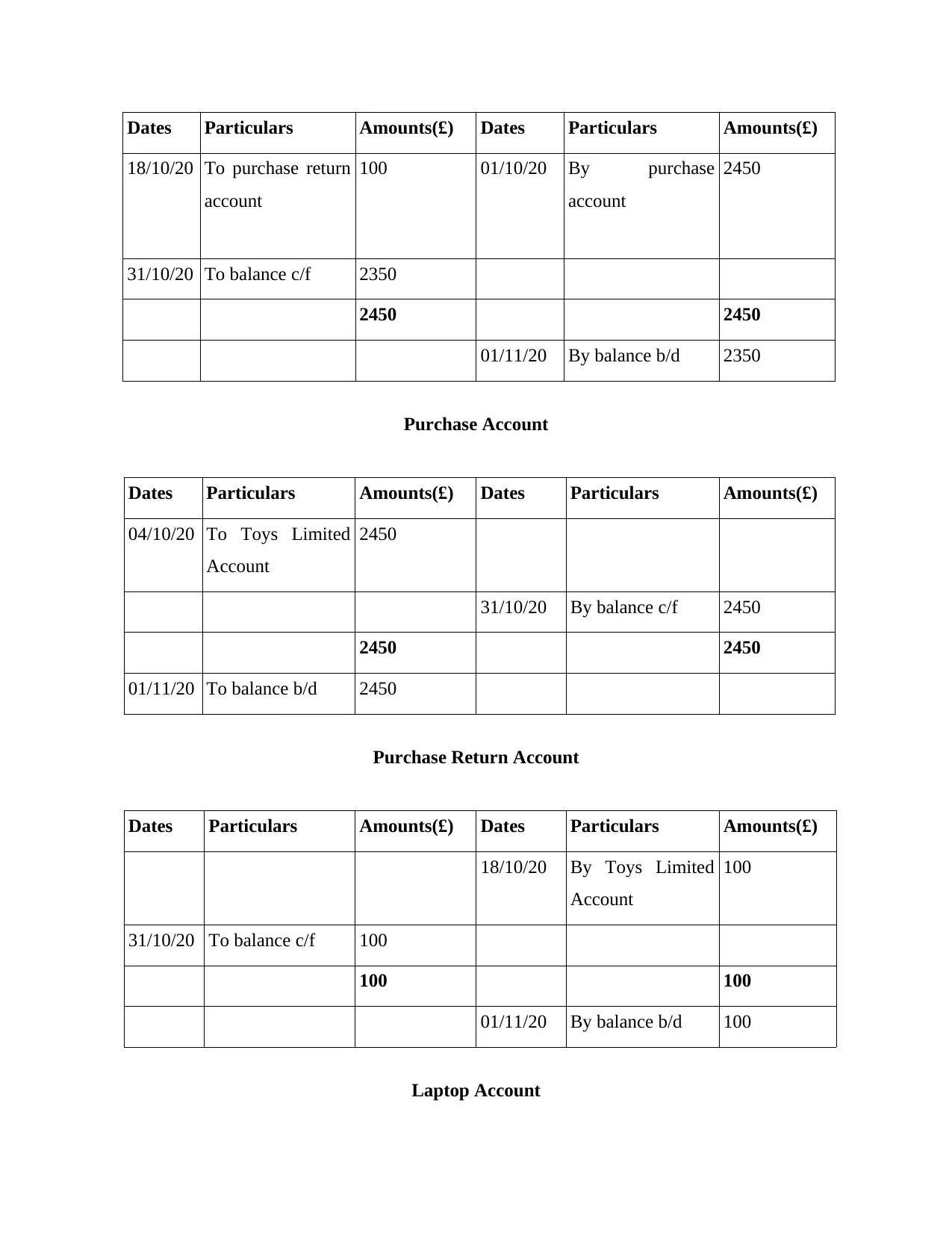
Dates Particulars Amounts(£) Dates Particulars Amounts(£)
18/10/20 To purchase return
account
100 01/10/20 By purchase
account
2450
31/10/20 To balance c/f 2350
2450 2450
01/11/20 By balance b/d 2350
Purchase Account
Dates Particulars Amounts(£) Dates Particulars Amounts(£)
04/10/20 To Toys Limited
Account
2450
31/10/20 By balance c/f 2450
2450 2450
01/11/20 To balance b/d 2450
Purchase Return Account
Dates Particulars Amounts(£) Dates Particulars Amounts(£)
18/10/20 By Toys Limited
Account
100
31/10/20 To balance c/f 100
100 100
01/11/20 By balance b/d 100
Laptop Account
18/10/20 To purchase return
account
100 01/10/20 By purchase
account
2450
31/10/20 To balance c/f 2350
2450 2450
01/11/20 By balance b/d 2350
Purchase Account
Dates Particulars Amounts(£) Dates Particulars Amounts(£)
04/10/20 To Toys Limited
Account
2450
31/10/20 By balance c/f 2450
2450 2450
01/11/20 To balance b/d 2450
Purchase Return Account
Dates Particulars Amounts(£) Dates Particulars Amounts(£)
18/10/20 By Toys Limited
Account
100
31/10/20 To balance c/f 100
100 100
01/11/20 By balance b/d 100
Laptop Account
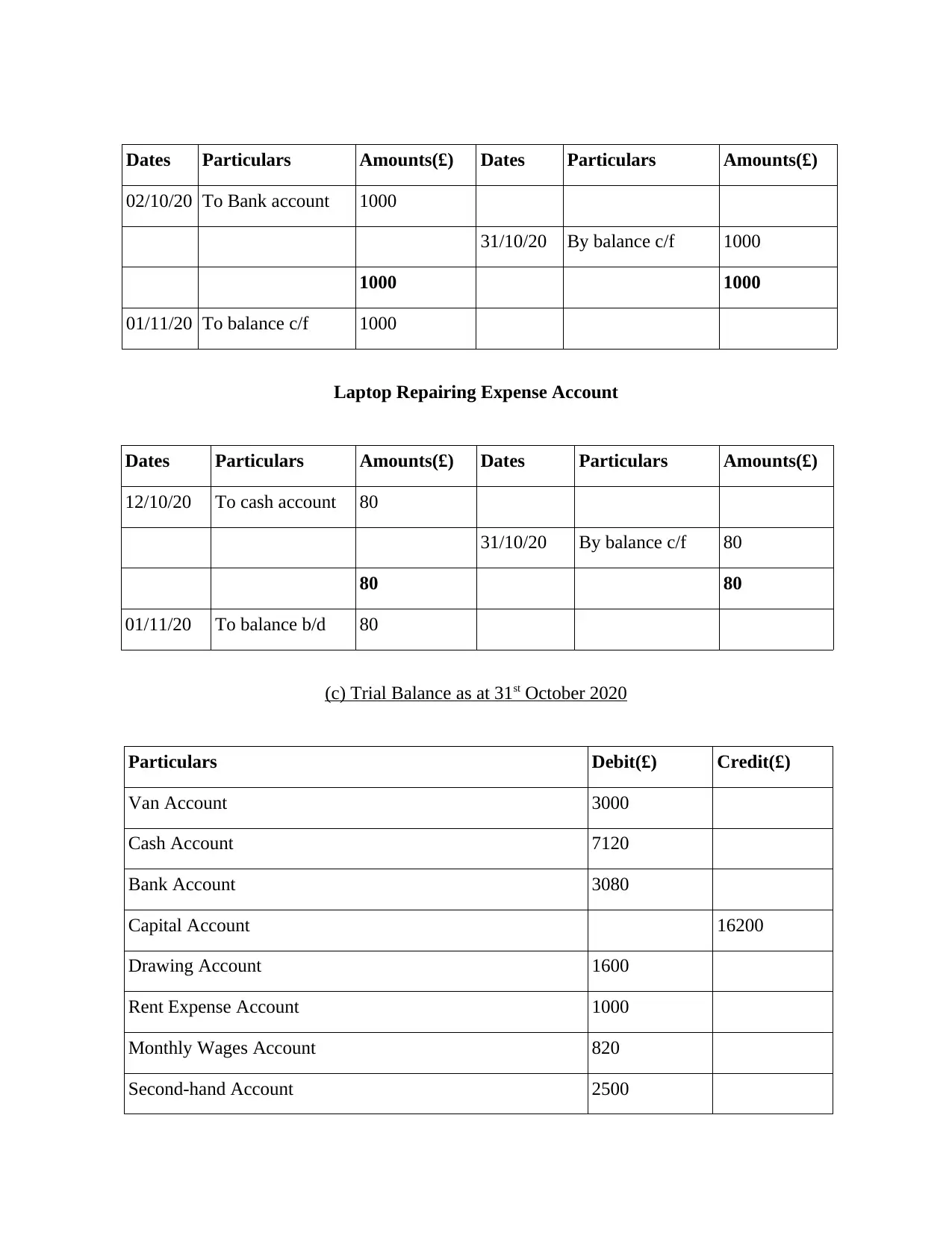
Dates Particulars Amounts(£) Dates Particulars Amounts(£)
02/10/20 To Bank account 1000
31/10/20 By balance c/f 1000
1000 1000
01/11/20 To balance c/f 1000
Laptop Repairing Expense Account
Dates Particulars Amounts(£) Dates Particulars Amounts(£)
12/10/20 To cash account 80
31/10/20 By balance c/f 80
80 80
01/11/20 To balance b/d 80
(c) Trial Balance as at 31st October 2020
Particulars Debit(£) Credit(£)
Van Account 3000
Cash Account 7120
Bank Account 3080
Capital Account 16200
Drawing Account 1600
Rent Expense Account 1000
Monthly Wages Account 820
Second-hand Account 2500
02/10/20 To Bank account 1000
31/10/20 By balance c/f 1000
1000 1000
01/11/20 To balance c/f 1000
Laptop Repairing Expense Account
Dates Particulars Amounts(£) Dates Particulars Amounts(£)
12/10/20 To cash account 80
31/10/20 By balance c/f 80
80 80
01/11/20 To balance b/d 80
(c) Trial Balance as at 31st October 2020
Particulars Debit(£) Credit(£)
Van Account 3000
Cash Account 7120
Bank Account 3080
Capital Account 16200
Drawing Account 1600
Rent Expense Account 1000
Monthly Wages Account 820
Second-hand Account 2500
Secure Best Marks with AI Grader
Need help grading? Try our AI Grader for instant feedback on your assignments.

Sales Account 3900
Rental Income Account 500
Fred (Debtor) Account 400
Toys Limited (Creditor) Account 2350
Purchase Account 2450
Purchase Return Account 100
Laptop Account 1000
Laptop Repairing Expense Account 80
Total 23050 23050
(d) Income Statement
Particulars Amounts(£)
Net Sales Revenue 3900
Less Cost Of Goods Sold* -2920
Gross Profit 980
Add Operating Income* 500
Less Operating Expenses* -1080
Net Profit 400
*Cost of goods sold
Particulars Amounts(£)
Opening Stock 0
Add Purchase of Raw material 2450
Add Monthly wages 820
Rental Income Account 500
Fred (Debtor) Account 400
Toys Limited (Creditor) Account 2350
Purchase Account 2450
Purchase Return Account 100
Laptop Account 1000
Laptop Repairing Expense Account 80
Total 23050 23050
(d) Income Statement
Particulars Amounts(£)
Net Sales Revenue 3900
Less Cost Of Goods Sold* -2920
Gross Profit 980
Add Operating Income* 500
Less Operating Expenses* -1080
Net Profit 400
*Cost of goods sold
Particulars Amounts(£)
Opening Stock 0
Add Purchase of Raw material 2450
Add Monthly wages 820

Less Purchase return -100
Less Closing stock -250
COGS 2920
*Operation income
Particulars Amounts(£)
Rental Income 500
Total 500
*Operating Expenses
Particulars Amounts(£)
Repairing expense 80
Rent Expense 1000
Total Net operating expenses 1080
(e) Balance Sheet as at 31st October 2020
Particulars Details Amount
ASSETS
Non-current assets:
Fixed and Tangible assets: 6500
Laptop 1000
Van 3000
Second-hand Car 2500
Current assets:
Less Closing stock -250
COGS 2920
*Operation income
Particulars Amounts(£)
Rental Income 500
Total 500
*Operating Expenses
Particulars Amounts(£)
Repairing expense 80
Rent Expense 1000
Total Net operating expenses 1080
(e) Balance Sheet as at 31st October 2020
Particulars Details Amount
ASSETS
Non-current assets:
Fixed and Tangible assets: 6500
Laptop 1000
Van 3000
Second-hand Car 2500
Current assets:
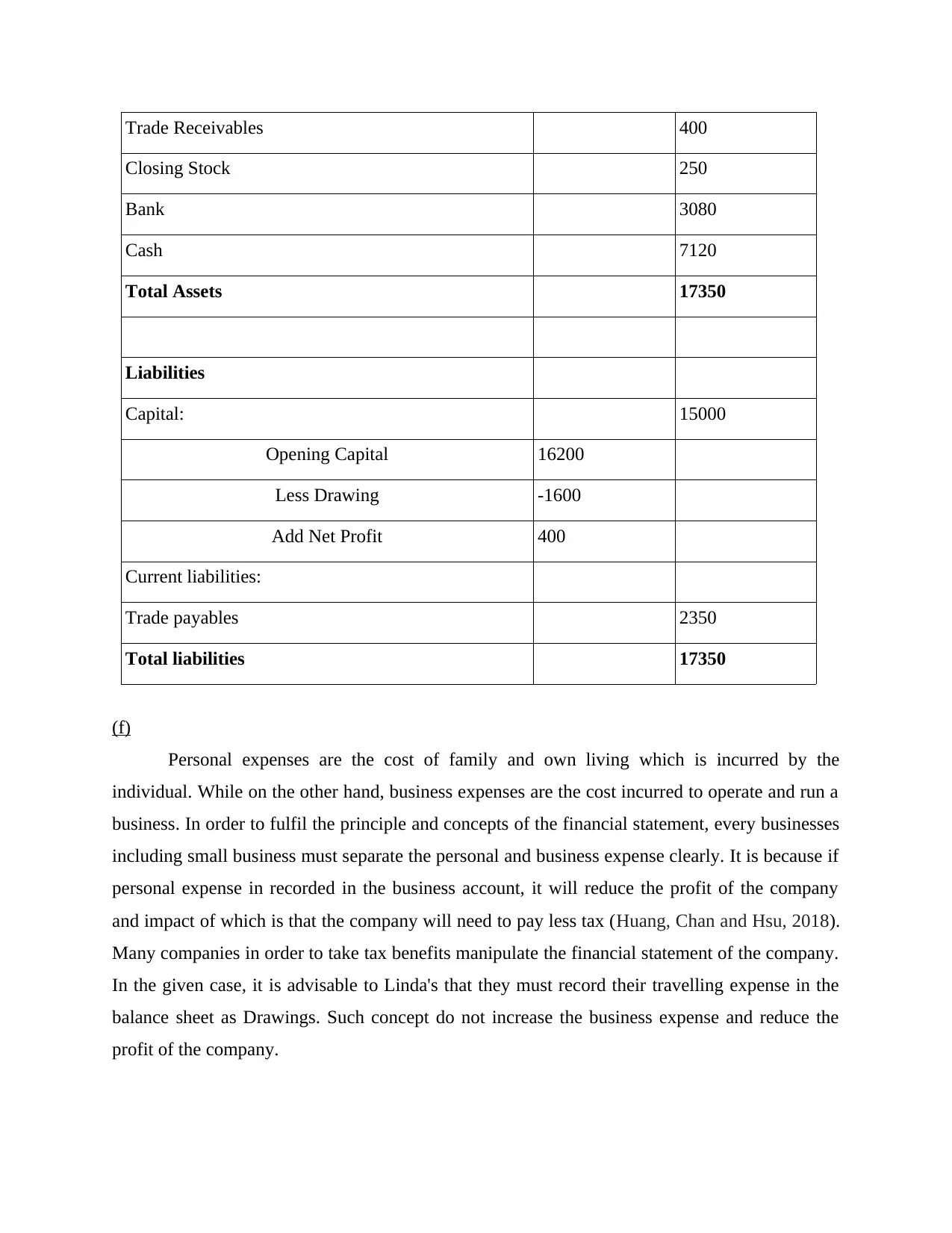
Trade Receivables 400
Closing Stock 250
Bank 3080
Cash 7120
Total Assets 17350
Liabilities
Capital: 15000
Opening Capital 16200
Less Drawing -1600
Add Net Profit 400
Current liabilities:
Trade payables 2350
Total liabilities 17350
(f)
Personal expenses are the cost of family and own living which is incurred by the
individual. While on the other hand, business expenses are the cost incurred to operate and run a
business. In order to fulfil the principle and concepts of the financial statement, every businesses
including small business must separate the personal and business expense clearly. It is because if
personal expense in recorded in the business account, it will reduce the profit of the company
and impact of which is that the company will need to pay less tax (Huang, Chan and Hsu, 2018).
Many companies in order to take tax benefits manipulate the financial statement of the company.
In the given case, it is advisable to Linda's that they must record their travelling expense in the
balance sheet as Drawings. Such concept do not increase the business expense and reduce the
profit of the company.
Closing Stock 250
Bank 3080
Cash 7120
Total Assets 17350
Liabilities
Capital: 15000
Opening Capital 16200
Less Drawing -1600
Add Net Profit 400
Current liabilities:
Trade payables 2350
Total liabilities 17350
(f)
Personal expenses are the cost of family and own living which is incurred by the
individual. While on the other hand, business expenses are the cost incurred to operate and run a
business. In order to fulfil the principle and concepts of the financial statement, every businesses
including small business must separate the personal and business expense clearly. It is because if
personal expense in recorded in the business account, it will reduce the profit of the company
and impact of which is that the company will need to pay less tax (Huang, Chan and Hsu, 2018).
Many companies in order to take tax benefits manipulate the financial statement of the company.
In the given case, it is advisable to Linda's that they must record their travelling expense in the
balance sheet as Drawings. Such concept do not increase the business expense and reduce the
profit of the company.
Paraphrase This Document
Need a fresh take? Get an instant paraphrase of this document with our AI Paraphraser
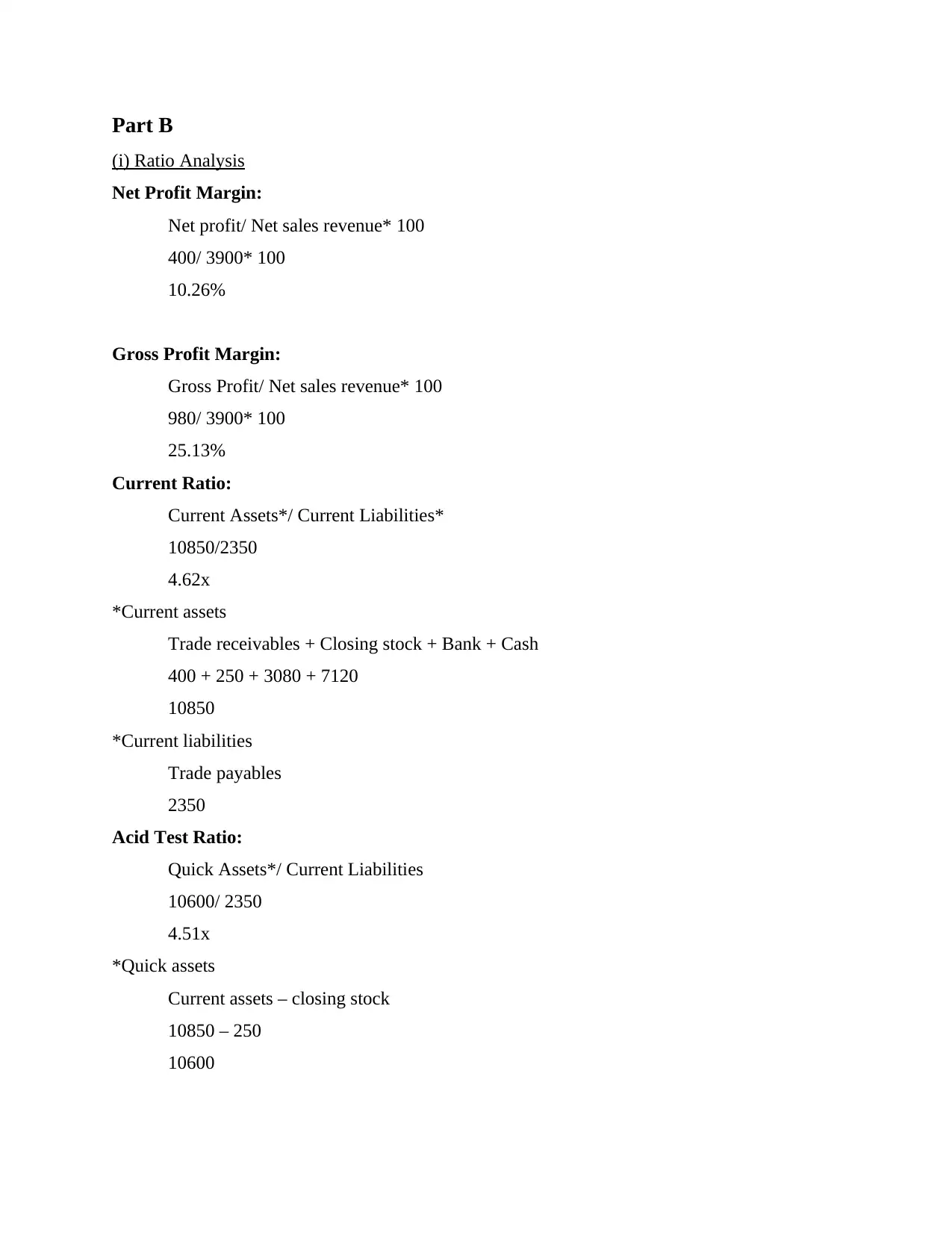
Part B
(i) Ratio Analysis
Net Profit Margin:
Net profit/ Net sales revenue* 100
400/ 3900* 100
10.26%
Gross Profit Margin:
Gross Profit/ Net sales revenue* 100
980/ 3900* 100
25.13%
Current Ratio:
Current Assets*/ Current Liabilities*
10850/2350
4.62x
*Current assets
Trade receivables + Closing stock + Bank + Cash
400 + 250 + 3080 + 7120
10850
*Current liabilities
Trade payables
2350
Acid Test Ratio:
Quick Assets*/ Current Liabilities
10600/ 2350
4.51x
*Quick assets
Current assets – closing stock
10850 – 250
10600
(i) Ratio Analysis
Net Profit Margin:
Net profit/ Net sales revenue* 100
400/ 3900* 100
10.26%
Gross Profit Margin:
Gross Profit/ Net sales revenue* 100
980/ 3900* 100
25.13%
Current Ratio:
Current Assets*/ Current Liabilities*
10850/2350
4.62x
*Current assets
Trade receivables + Closing stock + Bank + Cash
400 + 250 + 3080 + 7120
10850
*Current liabilities
Trade payables
2350
Acid Test Ratio:
Quick Assets*/ Current Liabilities
10600/ 2350
4.51x
*Quick assets
Current assets – closing stock
10850 – 250
10600

Accounts Receivable Collection Period:
No. of days in a year/ Average debtors turnover ratio*
365 days/ 2 times
182.5 days
*ADTR
Net Credit sales/ Average debtors
3900/ (0+200/2)
2 times
NOTE: In the given question it is not specify the figure of net credit sales, so it is assumed that
the total sales revenue is equal to net credit sales.
Accounts Payable Payment Period:
No. of days in a year/ Average creditors turnover ratio*
365days/ 2 times
182.5 days
*ACTR
Net credit purchase/ Average creditors
2350/ (0+1175/2)
2 times
NOTE: As in the given question it is not possible to identify the net credit purchase, so it is
assumed that the whole purchase after subtracting purchase return as net credit purchase.
(ii) Evaluation of the Linda's business performance on the basis of ratio analysis
Net profit margin and gross profit margin of the Linda's business is 10.26% and 25.13%
respectively and also less than its competitors. This indicate that the profitability of the Linda's
business is lower and suffering at huge stage. The current ratio and acid test ratio of the Linda's
business is 4.62x and 4.51x which indicate that the business is unable to cover its current
obligation easily with the use of current assets only (Palepu and et.al., 2020). The accounts
receivable collection period of the Linda's business is higher that its competitors which shows
that the Linda;s business is unable to receive its payments from the debtors earlier. But on the
other hand, the accounts payable payment period of the Linda's business is higher than its
competitors. But it is not good for the company because if Linda take that much time to pay its
No. of days in a year/ Average debtors turnover ratio*
365 days/ 2 times
182.5 days
*ADTR
Net Credit sales/ Average debtors
3900/ (0+200/2)
2 times
NOTE: In the given question it is not specify the figure of net credit sales, so it is assumed that
the total sales revenue is equal to net credit sales.
Accounts Payable Payment Period:
No. of days in a year/ Average creditors turnover ratio*
365days/ 2 times
182.5 days
*ACTR
Net credit purchase/ Average creditors
2350/ (0+1175/2)
2 times
NOTE: As in the given question it is not possible to identify the net credit purchase, so it is
assumed that the whole purchase after subtracting purchase return as net credit purchase.
(ii) Evaluation of the Linda's business performance on the basis of ratio analysis
Net profit margin and gross profit margin of the Linda's business is 10.26% and 25.13%
respectively and also less than its competitors. This indicate that the profitability of the Linda's
business is lower and suffering at huge stage. The current ratio and acid test ratio of the Linda's
business is 4.62x and 4.51x which indicate that the business is unable to cover its current
obligation easily with the use of current assets only (Palepu and et.al., 2020). The accounts
receivable collection period of the Linda's business is higher that its competitors which shows
that the Linda;s business is unable to receive its payments from the debtors earlier. But on the
other hand, the accounts payable payment period of the Linda's business is higher than its
competitors. But it is not good for the company because if Linda take that much time to pay its
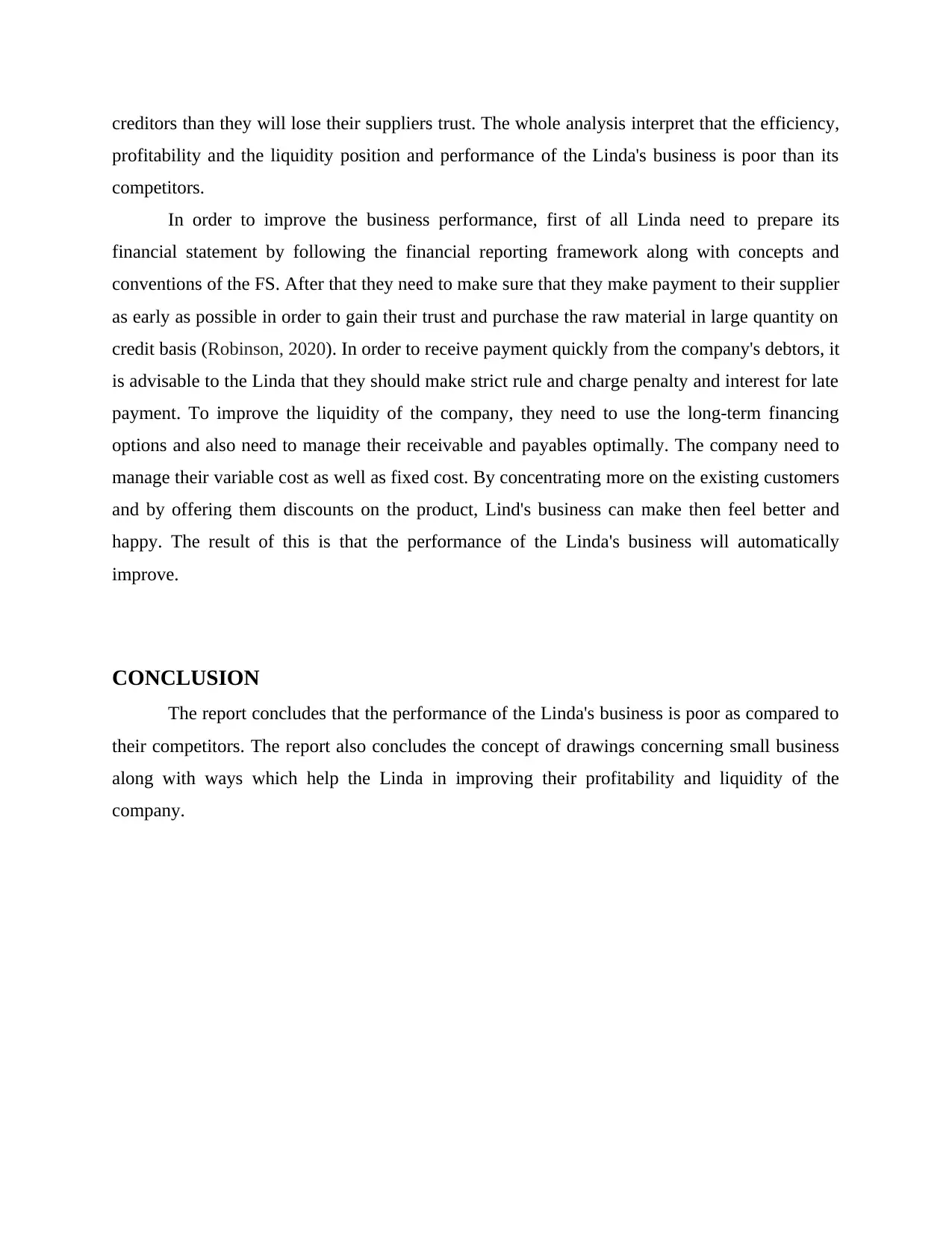
creditors than they will lose their suppliers trust. The whole analysis interpret that the efficiency,
profitability and the liquidity position and performance of the Linda's business is poor than its
competitors.
In order to improve the business performance, first of all Linda need to prepare its
financial statement by following the financial reporting framework along with concepts and
conventions of the FS. After that they need to make sure that they make payment to their supplier
as early as possible in order to gain their trust and purchase the raw material in large quantity on
credit basis (Robinson, 2020). In order to receive payment quickly from the company's debtors, it
is advisable to the Linda that they should make strict rule and charge penalty and interest for late
payment. To improve the liquidity of the company, they need to use the long-term financing
options and also need to manage their receivable and payables optimally. The company need to
manage their variable cost as well as fixed cost. By concentrating more on the existing customers
and by offering them discounts on the product, Lind's business can make then feel better and
happy. The result of this is that the performance of the Linda's business will automatically
improve.
CONCLUSION
The report concludes that the performance of the Linda's business is poor as compared to
their competitors. The report also concludes the concept of drawings concerning small business
along with ways which help the Linda in improving their profitability and liquidity of the
company.
profitability and the liquidity position and performance of the Linda's business is poor than its
competitors.
In order to improve the business performance, first of all Linda need to prepare its
financial statement by following the financial reporting framework along with concepts and
conventions of the FS. After that they need to make sure that they make payment to their supplier
as early as possible in order to gain their trust and purchase the raw material in large quantity on
credit basis (Robinson, 2020). In order to receive payment quickly from the company's debtors, it
is advisable to the Linda that they should make strict rule and charge penalty and interest for late
payment. To improve the liquidity of the company, they need to use the long-term financing
options and also need to manage their receivable and payables optimally. The company need to
manage their variable cost as well as fixed cost. By concentrating more on the existing customers
and by offering them discounts on the product, Lind's business can make then feel better and
happy. The result of this is that the performance of the Linda's business will automatically
improve.
CONCLUSION
The report concludes that the performance of the Linda's business is poor as compared to
their competitors. The report also concludes the concept of drawings concerning small business
along with ways which help the Linda in improving their profitability and liquidity of the
company.
Secure Best Marks with AI Grader
Need help grading? Try our AI Grader for instant feedback on your assignments.

REFERENCE
Books & Journals
Famiola, M. and Hartati, S., 2018. Entrepreneurship learning system in business incubators: A
case study in Indonesia. International Journal of Engineering & Technology, 7(4.28),
pp.57-62.
Huang, Y. C., Chan, J. Y. H. and Hsu, J., 2018, April. Reflection before/after practice:
learnersourcing for drawing support. In Extended Abstracts of the 2018 CHI
Conference on Human Factors in Computing Systems (pp. 1-6).
Palepu, K. G. and et.al., 2020. Business analysis and valuation: Using financial statements.
Cengage AU.
Shehab, S. F., 2019. Evaluating financial performance in Islamic banks Applied Study on the
Islamic Elaf Bank in Iraq. Tikrit Journal of Administration and Economics
Sciences, 15(45 Part 1).
Ardila, I., Zurriah, R. and Suryani, Y., 2019. Preparation of financial statements based on
financial accounting standards for micro, small and medium entities. International
Journal of Accounting & Finance in Asia Pasific (IJAFAP), 2(3), pp.1-6.
Robinson, T. R., 2020. International financial statement analysis. John Wiley & Sons.
Lubawa, G. and Van Auken, H. E., 2018. Preparation and Use of Financial Statements
byFamily owned-SMEs in Tanzania: A case Study of Sunflowers Oil Processors in
Dodoma Region. Effect Of Social And Human Capital On Access To Financial
Capital For Smes: A Comparative, p.18.
Books & Journals
Famiola, M. and Hartati, S., 2018. Entrepreneurship learning system in business incubators: A
case study in Indonesia. International Journal of Engineering & Technology, 7(4.28),
pp.57-62.
Huang, Y. C., Chan, J. Y. H. and Hsu, J., 2018, April. Reflection before/after practice:
learnersourcing for drawing support. In Extended Abstracts of the 2018 CHI
Conference on Human Factors in Computing Systems (pp. 1-6).
Palepu, K. G. and et.al., 2020. Business analysis and valuation: Using financial statements.
Cengage AU.
Shehab, S. F., 2019. Evaluating financial performance in Islamic banks Applied Study on the
Islamic Elaf Bank in Iraq. Tikrit Journal of Administration and Economics
Sciences, 15(45 Part 1).
Ardila, I., Zurriah, R. and Suryani, Y., 2019. Preparation of financial statements based on
financial accounting standards for micro, small and medium entities. International
Journal of Accounting & Finance in Asia Pasific (IJAFAP), 2(3), pp.1-6.
Robinson, T. R., 2020. International financial statement analysis. John Wiley & Sons.
Lubawa, G. and Van Auken, H. E., 2018. Preparation and Use of Financial Statements
byFamily owned-SMEs in Tanzania: A case Study of Sunflowers Oil Processors in
Dodoma Region. Effect Of Social And Human Capital On Access To Financial
Capital For Smes: A Comparative, p.18.
1 out of 17
Related Documents
Your All-in-One AI-Powered Toolkit for Academic Success.
+13062052269
info@desklib.com
Available 24*7 on WhatsApp / Email
![[object Object]](/_next/static/media/star-bottom.7253800d.svg)
Unlock your academic potential
© 2024 | Zucol Services PVT LTD | All rights reserved.





